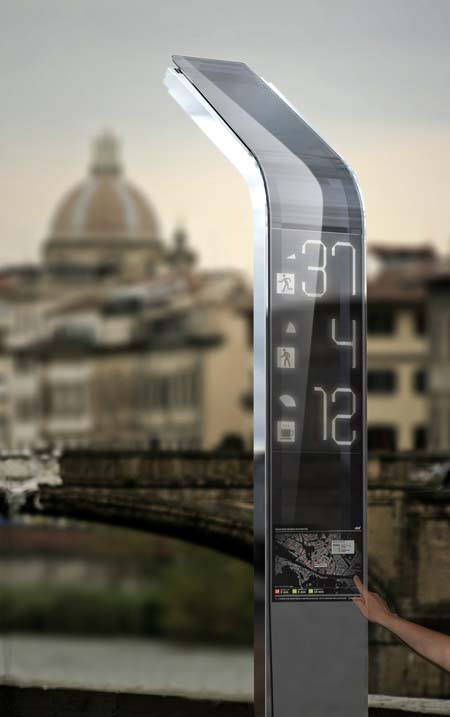MIT designing futuristic bus stops with integrated digital signage

FLORENCE, Italy — MIT architects and engineers have unveiled EyeStop, an interactive bus stop designed for the city of Florence. The project was presented officially on Saturday, May 16, at the Genio Fiorentino by the president of the Province of Florence, Matteo Renzi. Source: www.digitalsignagetoday.com.
EyeStop, developed by MIT’s SENSEable City Lab, is an exploration into the next generation of smart urban furniture; it aims to enrich the city with state of the art sensing technologies, interactive services, community information and entertainment. The project is partially covered with touch-sensitive e-INK and screens, so that it can deliver information to people seamlessly. Users can plan a bus trip on an interactive map, exchange community-relevant information on a digital message board, surf the Web, monitor their real time exposure to pollutants and use their mobile devices as an interface with the bus shelter.
“Interacting with EyeStop could change the access to urban information in a similar way to how the iPhone has changed our mobile life,” said Carlo Ratti, head of the SENSEable City Lab at MIT.
At the touch of a finger users can indicate their desired destination; the system will then display the shortest bus route from where they are and the position of all relevant buses real-time. The EyeStop will glow at different levels of intensity to signal the distance of an approaching bus. Riders and passers-by can also post ads and community announcements to an electronic bulletin board placed on the bus stop, enhancing its functionality as a public space — a place to gather and exchange community-relevant information.
In addition to displaying information, the bus stop also acts as an active environmental sensing node, powering itself through sunlight and collecting real-time information about air quality and the urban environment.
“EyeStop is an experiment into urban computing: it may be considered an ‘info-tape’ that snakes through the city, rising up like a pole or cropping out of the sidewalk like a shelter. It senses information about the environment and distributes it in a form accessible to all citizens,” said project leader Giovanni de Niederhousern.
A generative parametric model produces a unique design for each bus stop, providing both optimal sheltering for users and maximum sunlight exposure for direct photovoltaic powering. Unlike the typical mass-produced bus stop, EyeStop is designed to fit the physical characteristics of its surroundings, with each unit being slightly different from the others. Furthermore, simple materials like shiny steel, extra clear glass and gray local stone (pietra serena), together with its minimalist design, serve to optimize how it blends into the historic urban fabric of Florence.
“Since the Renaissance, there has been an interplay between the physical form of the city (urb) and its citizenship (civitas),” added Ratti. “Today’s technologies are adding new possibilities to that age-long relationship, thanks to the addition of digital information to physical space.”
EyeStop was developed at the SENSEable City Laboratory by Giovanni de Niederhousern, Shaocong Zhou, Assaf Biderman and Carlo Ratti, in collaboration with the Province of Florence and the local public transportation authority ATAF.

« The first totally solar-driven billboard scroller | Home | Bus shelters with air-conditioning »
Leave a Comment